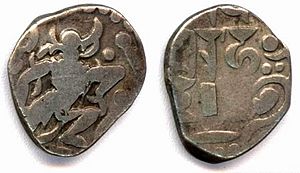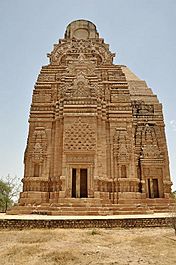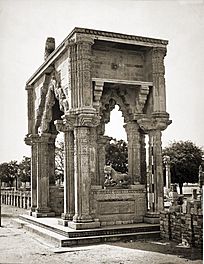Mihira Bhoja facts for kids
Quick facts for kids Mihira Bhoja |
|
|---|---|
| Adivaraha | |
| 6th Gurjara-Pratihara king | |
| Reign | c. 836 – c. 885 CE |
| Predecessor | Ramabhadra |
| Successor | Mahendrapala I |
| Died | 885 Narmada River |
| Issue | Mahendrapala I |
| Father | Ramabhadra |
| Religion | Hinduism |
Mihira Bhoja (around 836–885 CE), also known as Bhoja I, was a powerful king from the Gurjara-Pratihara Dynasty. He took over the throne after his father, Ramabhadra. Bhoja was a strong follower of Vishnu, a major Hindu god. He even took the special title Ādivarāha, which means "first boar incarnation of Vishnu." This title was also put on some of his coins. He was one of the most important leaders in India during the ninth century. Many people consider him a great general and someone who built a large empire.
At its biggest, Bhoja's empire stretched from the Narmada River in the south to the Sutlej River in the northwest. It also reached as far as Bengal in the east. This huge area included parts of the Himalayas and places like Etawah in Uttar Pradesh today.
A King's Rule
During Mihira Bhoja's time, the capital city was Kannauj. This city is in present-day Uttar Pradesh. Back then, Kannauj was also called Panchala.
King Bhoja was a strong opponent of the Arab invaders. An Arab historian named Sulaiman al-Tajir wrote that Bhoja had a very large army. This army was known for its excellent cavalry, which means soldiers who fought on horseback.
After his long and successful rule, Mihira Bhoja was followed by his son, Mahendrapala I.
Building an Empire
Mihira Bhoja first made his own lands strong. He stopped local leaders in Rajasthan who were rebelling. After that, he turned his attention to his old enemies, the Palas and the Rashtrakutas.
When Mihira Bhoja became king, his father Ramabhadra had faced some defeats. This had made the royal family less respected. Bhoja wanted to change that. He attacked the Pala Empire in Bengal, but he was defeated by their king, Devapala.
However, Bhoja didn't give up. He then started a campaign to conquer lands south of his empire. He was very successful in this effort. He took control of areas like Malwa, the Deccan, and Gujarat. In Gujarat, he got involved in a fight over who would be king. He supported the younger brother of Dhruva II of the Gujarat Rashtrakuta dynasty. Even though Dhruva II pushed back Bhoja's attack, Bhoja still managed to keep control over parts of Gujarat and Malwa.
The Pratiharas faced a big defeat in Ujjain against the Rashtrakutas of Gujarat. But the Pratiharas fought back. By the end of his rule, Bhoja had successfully defeated the Gujarat Rashtrakuta dynasty.
Besides being a great conqueror, Bhoja was also a smart diplomat. This means he was good at managing relationships with other kingdoms. Many kingdoms accepted his rule. These included Travani, Valla, Mada, Arya, Gujaratra, Lata Parvarta, and the Chandelas of Bundelkhand. An inscription from 843 AD confirms that Bhoja ruled the Dausa region. Another old record says that Bhoja's lands reached east of the Sutlej river.
An ancient text called Rajatarangini by Kalhana says that Bhoja's lands reached Kashmir in the north. It also mentions that Bhoja conquered Punjab by defeating the 'Thakkiyaka' dynasty there.
After King Devapala of the Palas died, Bhoja defeated the new Pala King, Narayanapala. This allowed Bhoja to expand his empire further east into Pala lands near Gorakhpur.
A Persian geography book from the tenth century, Hudud-ul-Alam, mentions that most kings in India respected the powerful 'Rai of Qinnauj'. Qinnauj (Kannauj) was the capital of the Pratihara Empire. This book states that the Pratihara army was very strong, with 150,000 cavalry soldiers and 800 war elephants.
Mihira Bhoja's son, Mahenderpal I, continued to expand the empire even further east. He conquered areas in Magadha, Bengal, and Assam between 890 and 910 CE.
Mihira Bhoja's Coins
Mihira Bhoja had a special title, Srimad-Adivaraha. This means "the fortunate primeval boar," referring to an incarnation of Vishnu. Because of this, experts agree that the "adivaraha dramma" coins belong to him. These coins show a picture of Adivaraha on the front. On the front, along with the god Adivaraha, there is a solar wheel with spokes on his right. On his left, there are other symbols like a mace, a lotus flower, and a conch-shell. Under the god's feet, there is likely a two-headed snake.
According to Alexander Cunningham, these types of coins are found only in silver and copper. It is believed that the copper coins were originally covered with a thin layer of silver. This made them look like silver coins and allowed them to be used as such.
These Adivarah coins were mentioned by Thakkar Pheru in his 13th-century book, Dravya-Pariksha. Thakkar Pheru was a mint master for Alauddin Khalji.





